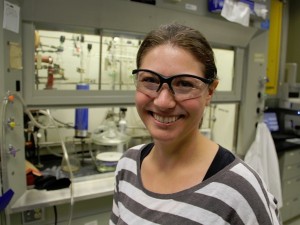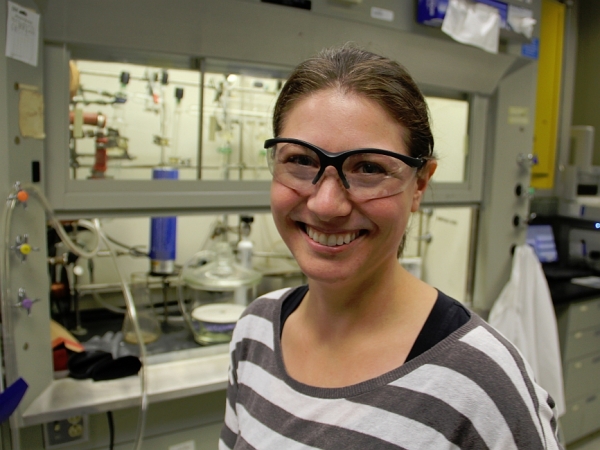
Jamie Garcia, a chemist at IBM, made a mistake that led to the discovery of the first new class of polymers in 20 years.
Scientists from IBM Research have successfully created a new class of polymer materials using computational chemistry.
The IBM researchers used high-performance computing to discover a new class of polymers that are resistant to cracking, stronger than bone, can reform to their original shape (self-heal), and are completely recyclable. Also, these materials can be transformed into new polymer structures to further bolster their strength by 50 per cent – making them strong and lightweight.
IBM scientists used a novel “computational chemistry” hybrid approach to accelerate the materials discovery process that couples lab experimentation with the use of high-performance computing to model new polymer forming reactions.
New materials are still primarily discovered by experimentation in the lab based on the scientist’s knowledge, experience and educated guesses. However IBM researchers’ use of computational chemistry can take out a lot of this guesswork and accelerate a whole new range of potential applications, from developing disease-specific drugs or cheap, light, tough and completely recyclable panels on a car.
IBM’s discovery of a new family of materials with a range of tuneable properties provides a new opportunity for exploratory research and applications development to academia, materials manufacturers and end users of high-performance materials. Two new related classes of materials have been discovered which possess a very distinctive range of properties that include high stiffness, solvent resistance, the ability to self-heal once a crack is introduced and can be used as a resin for filled composite materials to further bolster its strength.
Also, the ability to selectively recycle a structural component would have significant impact in the semiconductor industry, advanced manufacturing or advanced composites for transportation, as one would be able to rework high-value but defective manufactured parts or chips instead of throwing them away. This would bolster fabrication yields, save money and significantly decrease microelectronic waste.
Although there has been significant work in high-performance materials, today’s engineered polymers still lack several fundamental attributes. New materials innovation is critical to addressing major global challenges, developing new products and emerging disruptive technologies,” said James Hedrick, advanced organic materials scientist, IBM Research. “We’re now able to predict how molecules will respond to chemical reactions and build new polymer structures with significant guidance from computation that facilitates accelerated materials discovery. This is unique to IBM and allows us to address the complex needs of advanced materials for applications in transportation, microelectronic or advanced manufacturing.”
The polymers were formed through a condensation reaction at fairly low temperatures (just over room temperature) and with very inexpensive starting chemicals, one type of polymer is formed that is stronger than most polymers, but still maintains its flexibility because of solvent that is trapped within the network. If this material is heated to high temperatures, the polymer becomes even stronger due to a rearrangement of covalent bonds and loss of the solvent that is trapped in the polymer (now stronger than bone and fibreboard), but as a consequence is more brittle (similar to how glass shatters).

New polymer is stronger than bone, self-healing and solvent-resistant while being completely recyclable.
Additionally, polymers were constructed using the same technology but instead formed by reacting small, flexible pieces of a polymer. This new material displays very different properties than the ultra-strong polymers previously discussed. Instead of being robust, brittle, and strong, they form elastic gels with the solvent that they are produced in.
Probably the most unexpected and remarkable characteristic of these gels is that if they are severed and the pieces are placed back in proximity so they physically touch, the chemical bonds are reformed between the pieces making it a single unit again within seconds. This type of polymer is called a “self-healing” polymer because of its ability to do this and is made possible here due to hydrogen-bonding interactions in the hemiaminal polymer network. One could envision using these types of materials as adhesives or mixing in with other polymers to induce self-healing properties in the polymer mixture. Furthermore, these polymers are reversible constructs which means that can be recycled in neutral water, and that they might find use in applications that require reversible assemblies, such as drug cargo delivery.
Remarkably, both polymers remain intact when they are exposed to basic solution, but selectively decompose when exposed to a very acidic solution. A Slightly acidic solutions does not decompose either material. This means that under the right conditions, the polymer can be reverted back to its starting materials, which enables it for reuse for other polymers.
The material can also be manufactured to have even higher strength if carbon nanotubes or other reinforcing fillers are mixed into the polymer and are heated to high temperatures. This process enables polymers to have properties similar to metals which is why these ‘composite blends’ are used for manufacturing in airplane and cars. An advantage to using polymers in this case over metals is that they are more lightweight, which in the transportation industry translates to savings in fuel costs.
This story appears here as part of a cross-publishing agreement with Scientific Computing World.
You can read more about the polymer discovery at Science Journal.





Will there be a follow-up article to the “teaser” in the caption? I would like to hear a story about Jamie Garcia’s mistake!
Hi Jill, You can read the full story of the discovery here: http://www.sciencemag.org/content/344/6185/732
“This is the first new family of polymers discovered in 20 years. The first of these new materials were discovered by accident. Jeannette “Jamie” Garcia is a 31-year-old chemist at a laboratory managed by IBM. She was running an experiment, combining three chemicals in a beaker. The chemist forgot to add one of the ingredients to the mixture, before leaving the beaker alone. Soon, the compound formed a hard, white block that had to be broken out of the glass beaker. It wasn’t long before the team, headed by chemistry pioneer James Hedrick, started to test the physical properties of the new compound.”